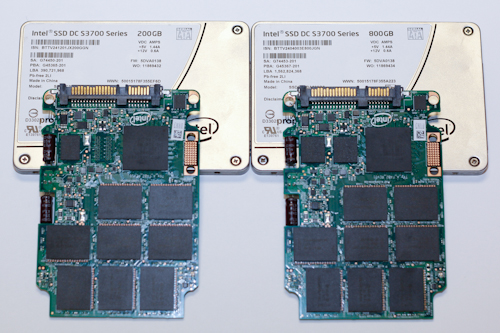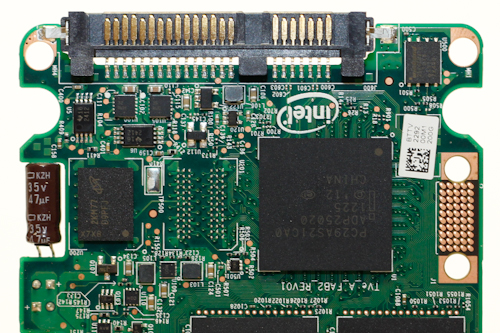Intel SSD DC S3700 Review: Benchmarking Consistency
With the recent announcement of the SSD DC S3700, Intel is firmly targeting enterprise customers with something not normally seen on spec sheets: performance consistency. Will their latest offering live up to expectations, or fall short? Lets find out.
Inside Intel's SSD DC S3700
We peeled the cover off of our 200 and 800 GB samples to get a better sense of hardware Intel is using. On both drives, it's easy to spot the new 6 Gb/s PC29AS21CA06 Gb/s controller. Again, it employs an eight-channel architecture instead of the 10-channel design used previously.
On the 800 GB drive, the controller is flanked by a pair of 4 Gb Samsung DDR3-1600 FBGA RAM packages, totaling 1 GB of cache. Below the controller, you see eight NAND packages, each adding 64 GB of capacity. The other side of the drive features eight more, pushing the 800 GB model's total capacity up to 1 TB.
The 200 GB version is configured quite a bit differently. The layout and controller are almost identical, but as you can see, there's a single 2 Gb DDR3 cache chip from Micron, rather than the two 4 Gb Samsung packages.
You still find 16 total NAND packages on-board. However, their densities aren't uniform. Fourteen of them are 16 GB chips, one adds 32 GB, and one is an 8 GB part, totaling 264 GB.
One of the SSD DC S3700's more unique enterprise-oriented features is the use of capacitors to maintain data integrity during a power failure. Two 35 V, 47 uF capacitors store enough charge to commit all data in the write cache to NAND. The radial electrolytic capacitors are bent into a cutout in the PCB, allowing Intel to free up board space that would have been needed for surface-mount capacitors.
Intel also incorporates sensor logic that periodically checks capacitor health. Any outright failure, or even degraded performance, triggers a SMART event and disables write caching to counter the risk of data loss.
Another first for Intel is utilization of the SATA connector's 12 V rail. In fact, the SSD DC S3700 can operate on +5 V, +12 V, or both. Granted, using the +12 V rail does increase power draw, but we'll go into more detail on that in the power consumption analysis.
Get Tom's Hardware's best news and in-depth reviews, straight to your inbox.
SSD DC S3700 Write Endurance
We typically spend a lot of time testing the write endurance of enterprise-oriented SSDs. Why? It's a big reason the highest-end SSDs cost so much more than the client-oriented stuff.
Intel uses the same 25 nm HET-MLC on its SSD DC S3700 that it put in the SSD 710 and 910. In fact, the company gives an identical write endurance spec for its 400 and 800 GB SSD DC S3700 and SSD 910 drives. There may be some differences in the way Intel's new controller handles TRIM and garbage collection, but they're likely very small.
| Endurance RatingSequential Workload, QD=1, 8 MB, Random | Intel SSD DC S3700 | Intel SSD 710 | Intel SSD 910 |
|---|---|---|---|
| NAND Type | Intel 25 nm HET-MLC | Intel 25 nm HET-MLC | Intel 25 nm HET-MLC |
| RAW NAND Capacity | 264 GB | 320 GB | 896 GB |
| IDEMA Capacity (User Accessible) | 200 GB | 200 GB | 800 GB |
| Over-provisioning | 32% | 60% | 12% |
| P/E Cycles Observed (IDEMA) | 36,343 | 36,600 | 46,339 |
| P/E Cycles Observed (Raw) | 27,532 | 22,875 | 41,374 |
| Host Writes per 1% of MWI | 72.69 TB | 73.20 TB | 370.71 TB |
| $/PB-Written | $64.66 | $181.72 | $106.60 |
Based on its over-provisioning and lower cost, the SSD DC S3700's cost per petabyte written is extremely low for an MLC-based drive. Of course, it cannot compete with the extreme endurance rating of SLC flash. Drives like Micron's RealSSD P320h reign supreme at less than $40 per petabyte written.
Will that change in the near future? If Intel manages to push the price of HET-MLC drives down to $1.40/GB (a 40% reduction from current prices), it would match the Micron drive in dollars per petabyte written. Considering the recent price history of Intel's HET-MLC-based drives and the rather static pricing of SLC-based devices in general, it doesn't seem far-fetched to anticipate this in the next 12 months.
Current page: Inside Intel's SSD DC S3700
Prev Page The SSD DC S3700: Meet Intel's Flagship Enterprise SSD Next Page Performance Consistency-
merikafyeah Consistency and reliability are always more important to me than speed and capacity,Reply
but it's wonderful when you can have all four.
Kudos to Intel for raising the bar yet again on SSD quality. Eagerly awaiting trickle-down effect. -
InvalidError adgjlsfhkhow does ssd power consumption compare to an hhd's in watts per gigabyte?For conventional 3.5" HDDs, you have 5-8W idle, 10-15W seek and 15-25W spin-up.Reply
For 2.5" HDDs, you have ~1W idle and 2-2.5W seek/spin-up.
I'm a little surprised at how much power Intel's enterprise SSDs are using. I'm guessing a good chunk of the reason comes from having extra circuitry to do the double-conversion from 5/12V to ~30V and then back down to whatever the SSD needs. -
drewriley InvalidErrorFor conventional 3.5" HDDs, you have 5-8W idle, 10-15W seek and 15-25W spin-up.For 2.5" HDDs, you have ~1W idle and 2-2.5W seek/spin-up.I'm a little surprised at how much power Intel's enterprise SSDs are using. I'm guessing a good chunk of the reason comes from having extra circuitry to do the double-conversion from 5/12V to ~30V and then back down to whatever the SSD needs.Reply
You nailed it. If you look at 2.5" 15K and 10K RPM drive, the Intel is better on W/GB, but it is pretty high when compared to other SSDs. -
master9716 Samsung aint gona mess around , they are going to bring this type of performance to Desktops watch .Reply
-
sanilmahambre So this is why they gave up on motherboards and concentrated more on SSD's! Believe me that trick worked wonders and a lot more money.. LOLReply -
mayankleoboy1 adgjlsfhkhow does ssd power consumption compare to an hhd's in watts per gigabyte?Reply
i am not sure if watt/GB is important for storage.
Reason : the new philosophy is to "hurry up, finish the work, and relax".



